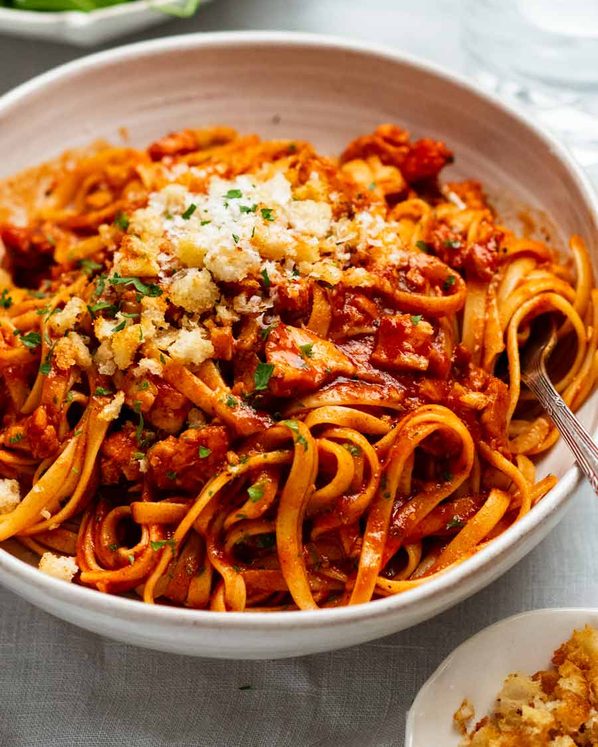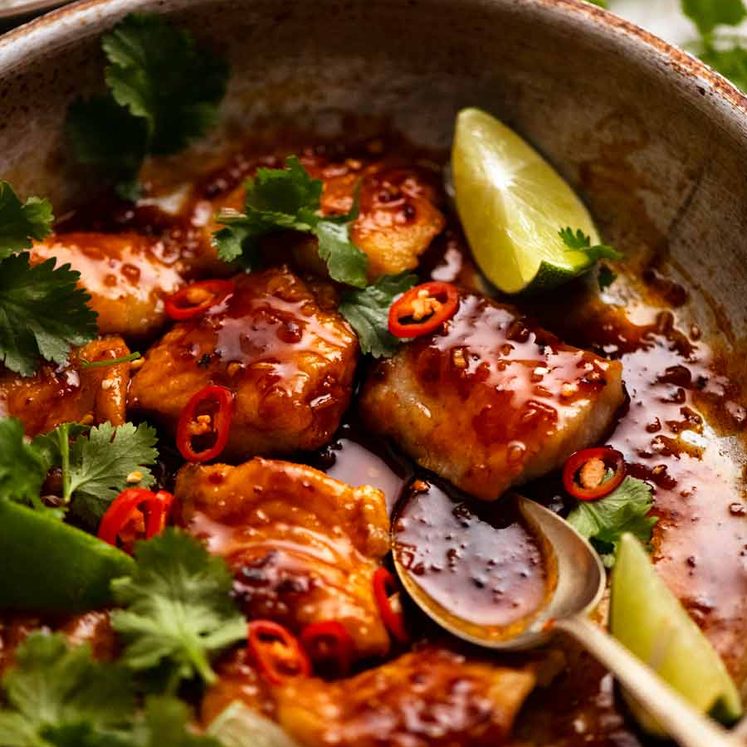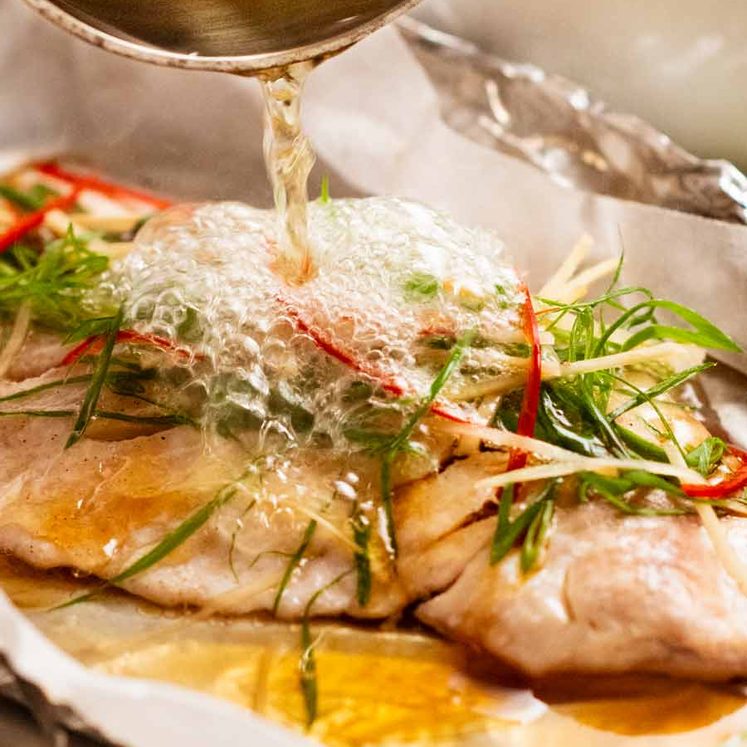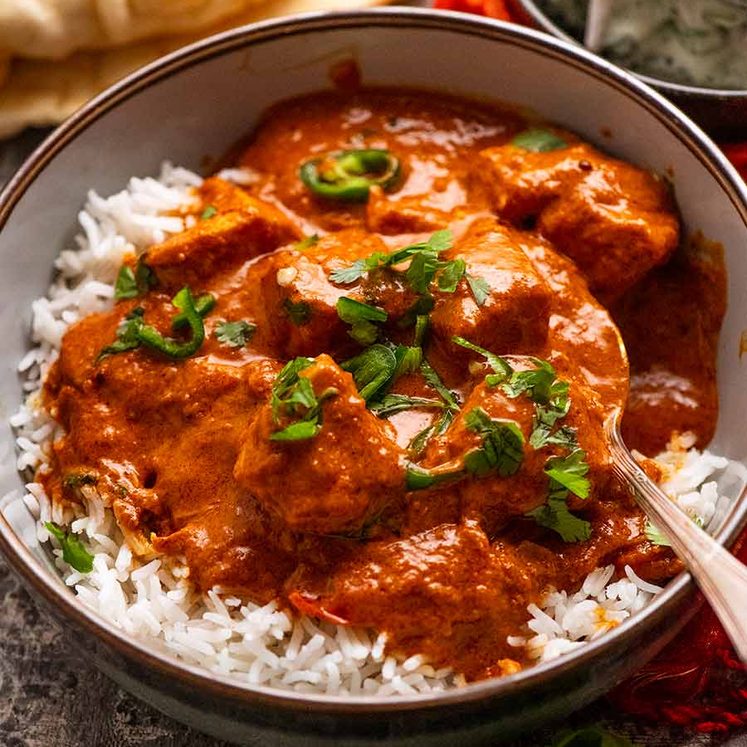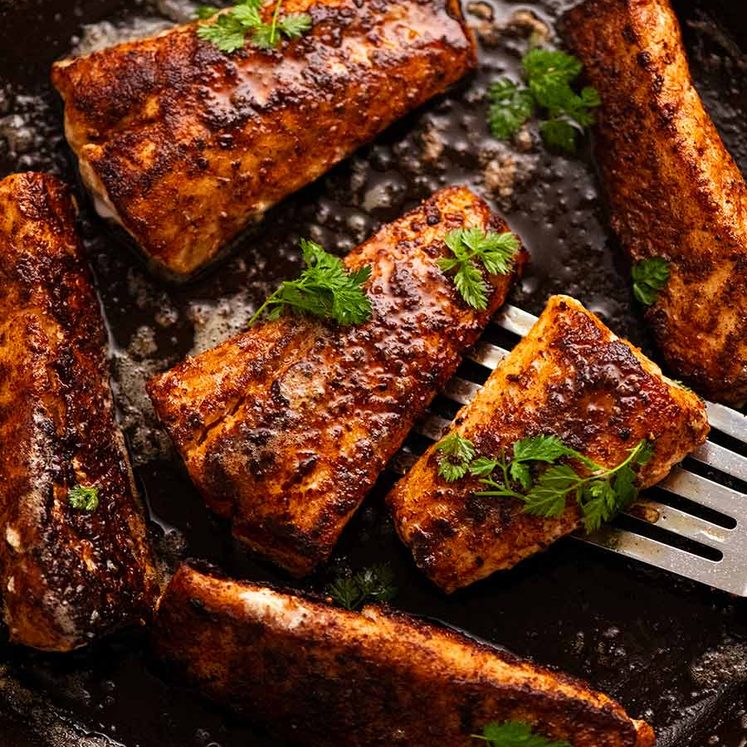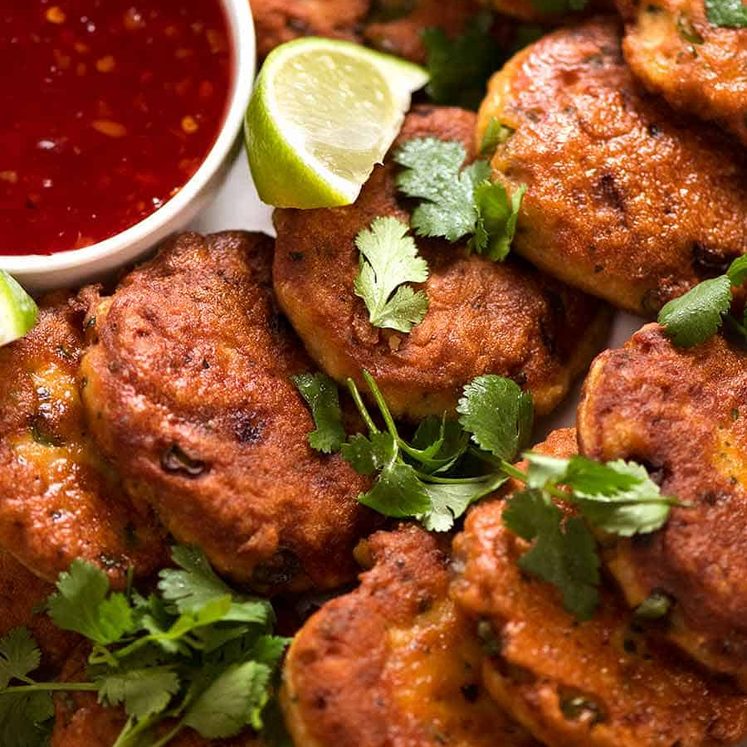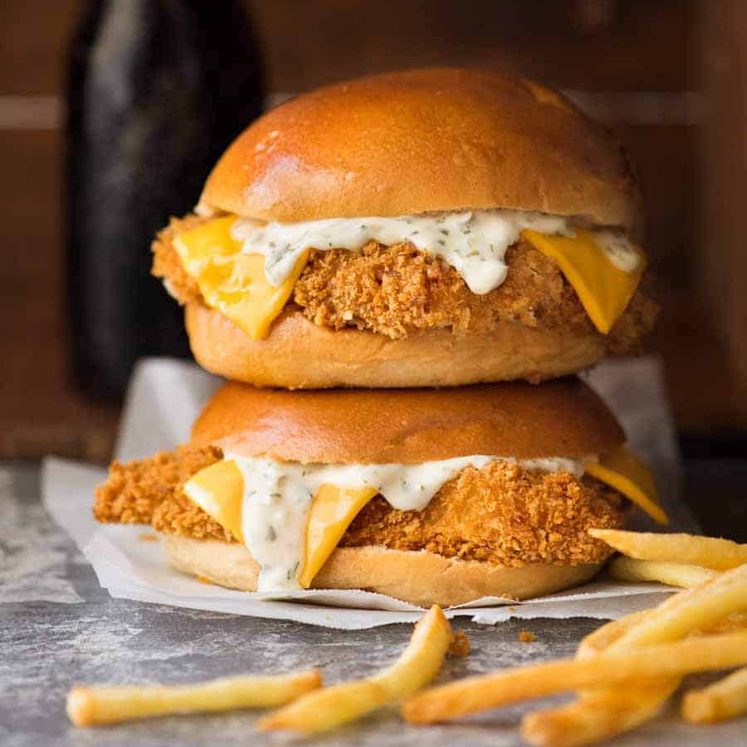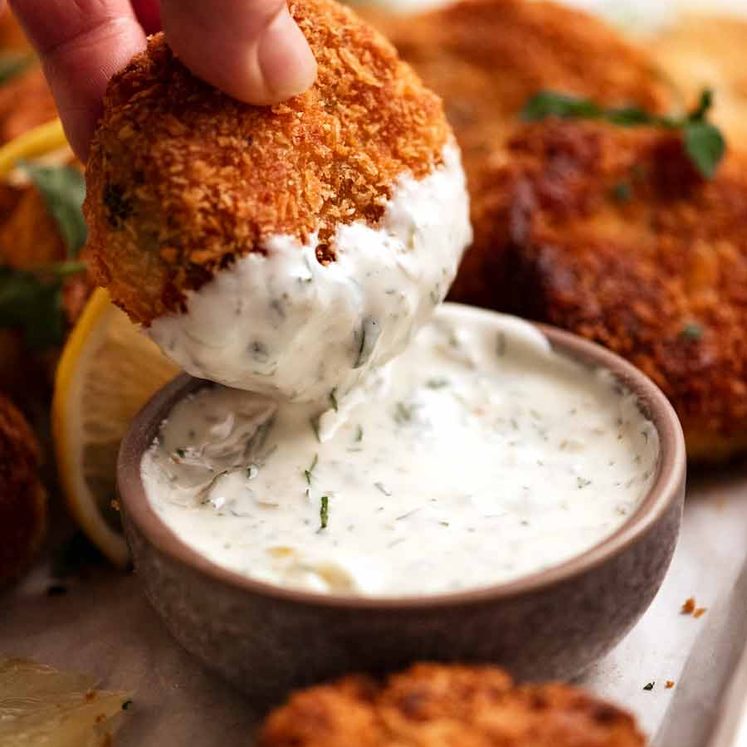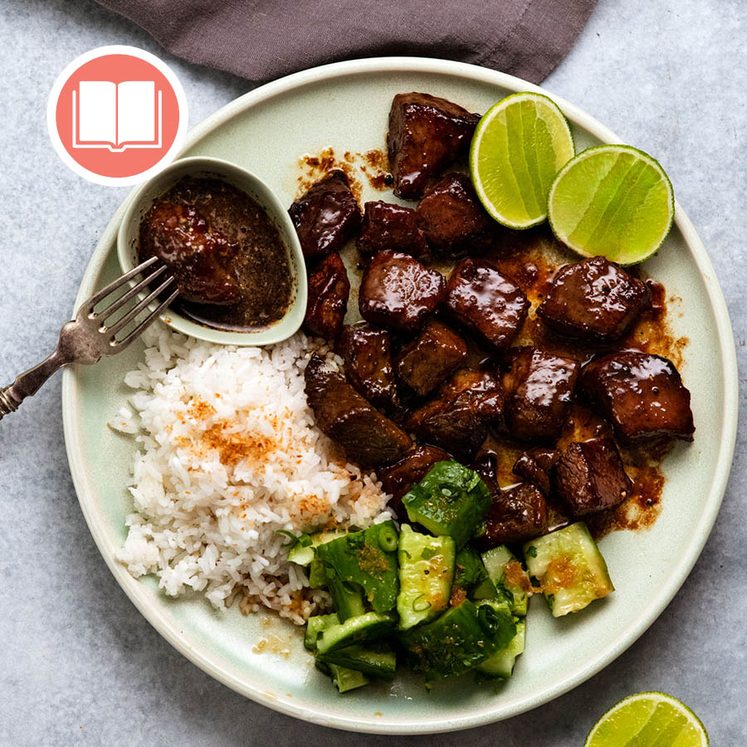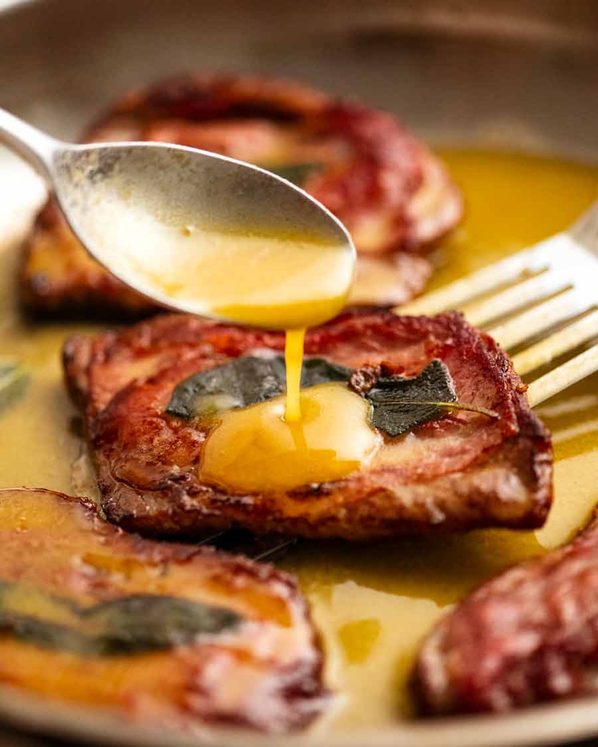This is a fish pasta in a richly flavoured fish ragu pasta sauce. It’s a great recipe to stretch fish further and cook it in a unique way that’s outrageously delicious with big, bold Italian Calabrian spices!
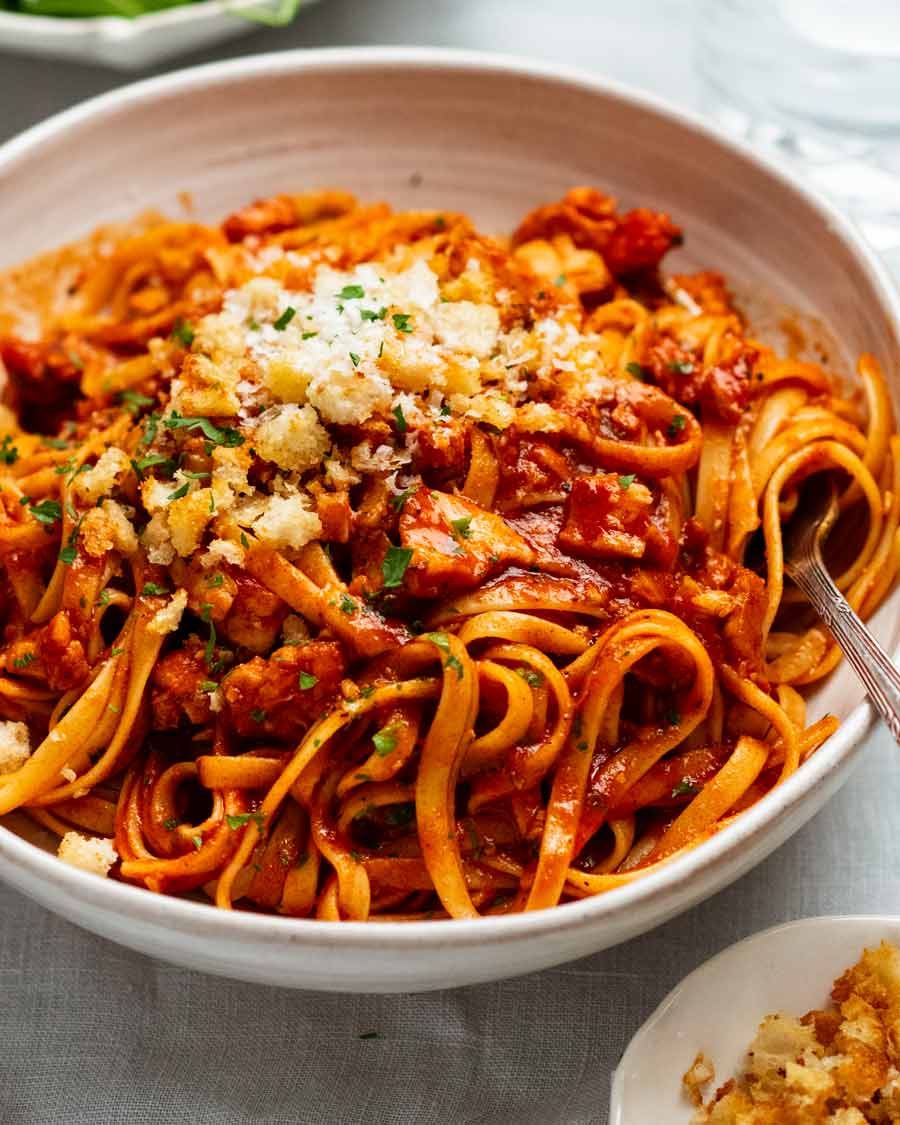
Calabrian Fish Ragu Pasta
I feel like the name of today’s recipe requires explanation.
I’m calling this a ragu because it’s stewy and braisy and has beautiful depth of flavour even though it hasn’t been slow cooked for hours like my Shredded Beef Ragu. Because, NEWSFLASH, it doesn’t have to be slow cooked for hours to be called a ragu!
As for the Calabrian part of the name? It’s because the seasoning is inspired by the flavours of Calabria: chillies and particularly nduja, the intensely-flavoured salami paste from the region that’s rising in popularity in the foodie world. Stuffed in focaccias, dolloped on pizzas, mixed into pasta sauces, this fiery spread has big, bold flavours and a little bit goes a long way.
So, as you might have guessed, this is a fish pasta that is big on flavour. I love that it tastes exotic and restaurant-y but it’s economical and easy!

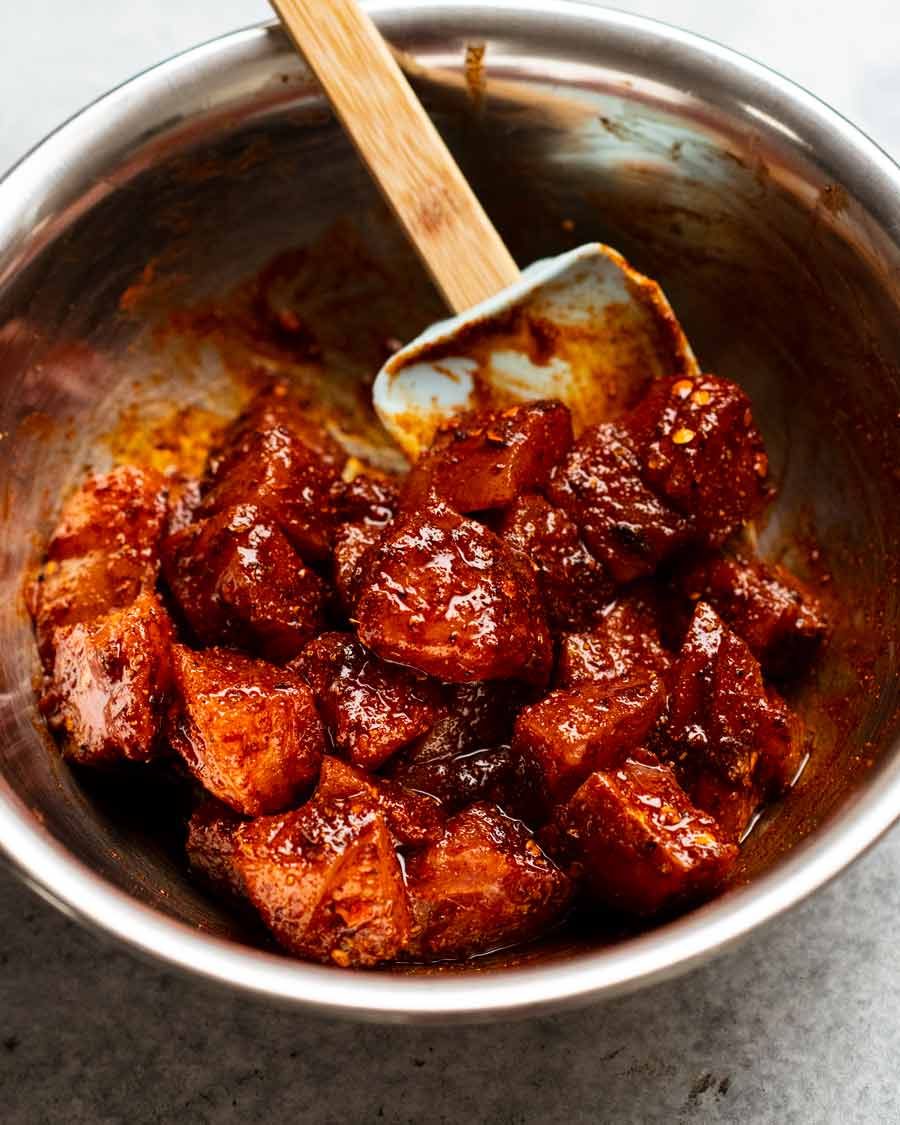

Ingredients in this Fish Ragu Pasta
Here’s what you need to make this.
1. The fish
Key to this pasta is the spice mix for the fish. As mentioned earlier, the flavours in this fish pasta are based on the seasoning on nduja which is a type of salami. So, think – fennel and paprika with a hit of spiciness. Bold is the word that comes to mind!
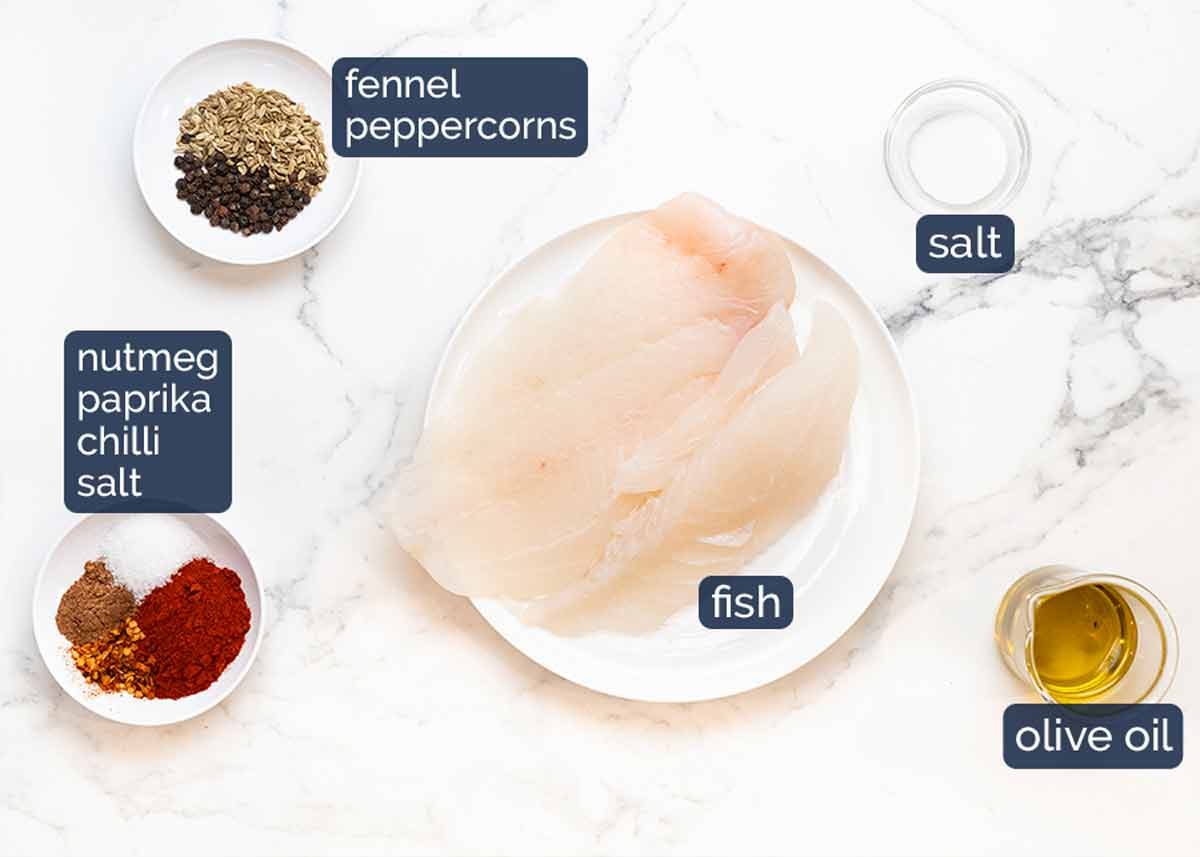
Best fish for this pasta
Any firm white fish fillets (skinless and boneless) can be used in this recipe. Here are some suggestions: snapper, John or Silver dory, barramundi, bream, tilapia, pollock, cod, flathead, perch, ling, bass, basa, hake, hoki, monkfish (pricey here, so I reserve for other uses like this recipe). If using frozen, thaw thoroughly and pat dry before using.
I recommend avoiding:
-
Fish that dry out easily when cooked – Like swordfish, tuna, bonito, kingfish, marlin.
-
Delicate and thin-filleted fish – Like flounder, sole, plaice, turbot, whiting. The texture of the flesh is a bit too delicate for this type of cooking.
-
Oily fish – Like sardines or mackerel. A bit too overwhelming, flavours don’t quite match.
The Calabrian spices
-
Whole fennel and black peppercorns – These are toasted then ground, for maximum flavour impact. I would not ask you to make the effort to toast and grind if I really didn’t believe it was worth it. It is! However, I have substitutions in the recipe notes for ground fennel and pepper, if that’s all you have.
-
More spices – Nutmeg, paprika, chilli flakes (red pepper flakes). Feel free to dial back the chilli if you’re concerned about spicineess.
2. In the pasta and the sauce
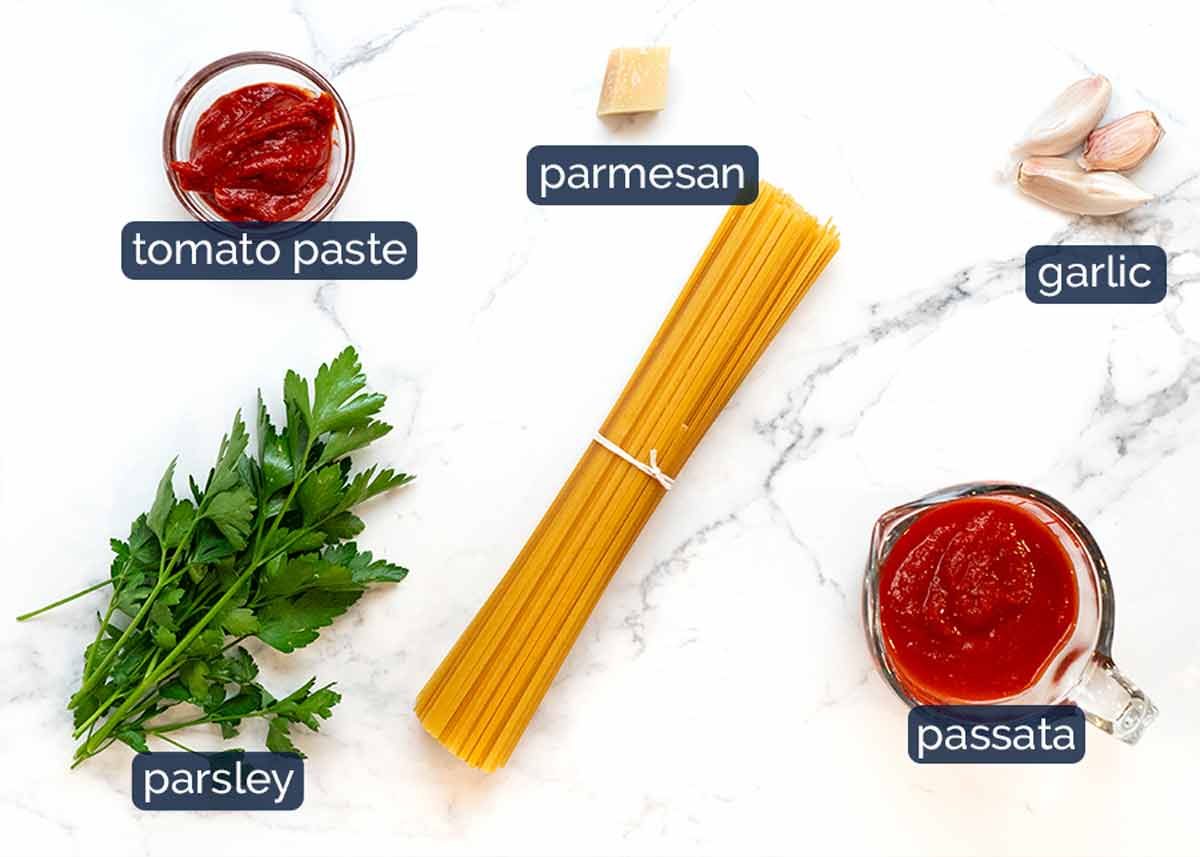
-
Pasta – Any long strand thinnish pasta is ideal here. I use fettuccine.
-
Tomato passata – This is pureed, strained pure tomatoes, sometimes labelled “tomato puree” in the US (here’s a photo of Mutti tomato passata sold at Walmart). It’s readily available in Australian supermarkets nowadays, alongside pasta sauces. It costs around the same as canned tomato.
Passata is excellent for making thick, smooth sauces and soups without a long simmer time like required to break down crushed tomato. A regular in my recipes! More on tomato passata here.
-
Tomato paste – A boost of tomatoey flavour and to help thicken the sauce.
-
Garlic – Because, garlic. Rarely do savoury recipes happen around here without garlic!
-
Parsley and parmesan – garnishes. I know parmesan isn’t strictly traditional in Italian fish and seafood pastas. But, it works. We’re not after loads of parmesan cheesiness. It just adds saltiness.
3. pangrattato
Pangrattato is an Italian chunky breadcrumb topping that adds an addictive crunch and flavor to pasta dishes and salads. I particularly like it with this fish ragu as it adds great texture and is a terrific contrast to the soft fish.
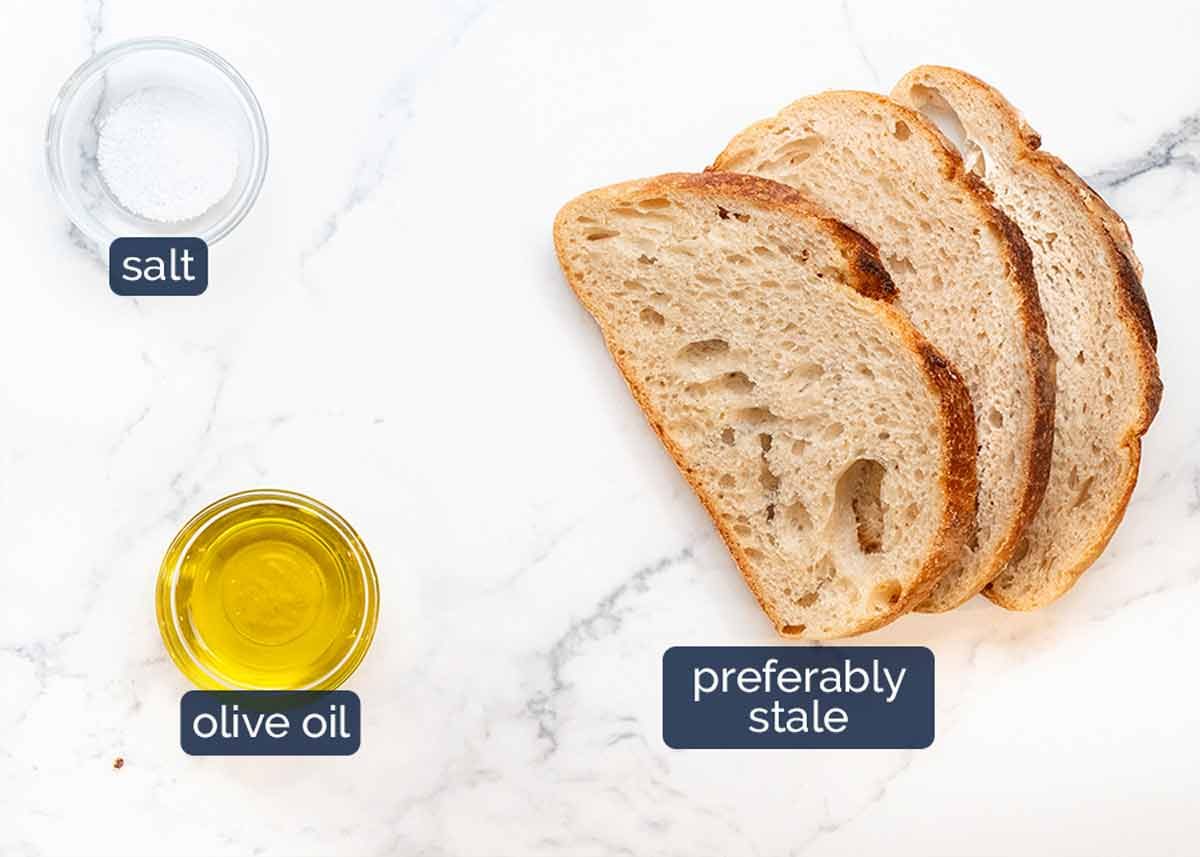
-
Bread – Use a denser bread like sourdough, ciabatta etc which have structure and go really crunchy when toasted. Lightweight sandwich bread is a little too delicate and kind of just dissolves into powder, bypassing the crunch completely. 🙂 BUT – if sandwich bread is all you have, I’d still go ahead! Or, substitute with panko breadcrumbs.
-
Oil and salt – To make it crunchy and salty.
How to make fish ragu
As mentioned earlier, this is a ragu but it doesn’t have to be slow cooked for hours! In fact, if you can multi-task, you’ll get this on the table in just over 20 minutes. 🙂
1. pangrattato first
Get the pangrattato in the oven first. Toss the bread in olive oil and salt, then bake in a 180°C / 350°F (160°C fan-forced) oven for 10 minutes until crisp all the way through.

2. CALABRIAN SPICED FISH NEXT
Next up, toast the spices and coat the fish in the tasty flavours.
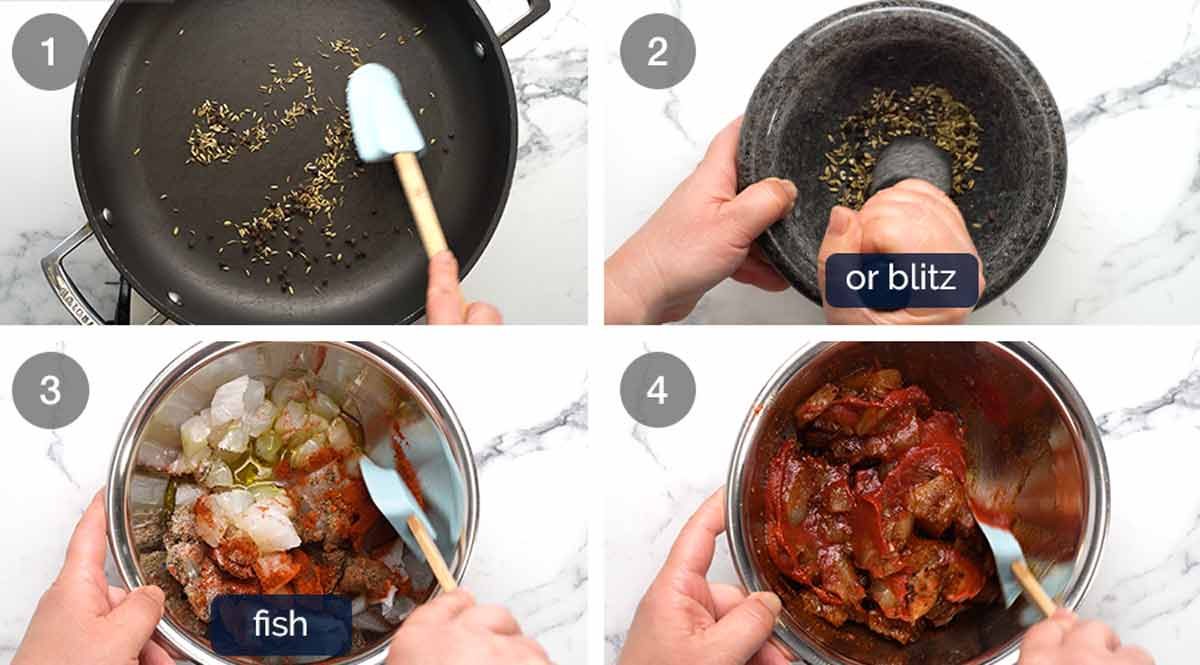
-
Toast the fennel and black peppercorns for a couple of minutes until it smells fragrant and you can see the fennel is lightly browned. Use a large deep skillet or pot, something large enough to toss the pasta with the sauce later. No oil required at this stage.
-
Grind the spices using a mortar and pestle, or a grinder.
-
Coat the fish with the ground fennel and peppercorns, nutmeg, chilli flakes, sugar, salt, olive oil plus the tomato paste.
-
Once coated, set aside while you prep the other ingredients. No need to marinate.
3. MAKING THE PASTA
The pasta sauce takes around the same time to cook as the pasta so you can make both at the same time.

-
Boil pasta for the time per the packet directions minus 1 minute. It should be al dente – cooked through but still a slight firm but. It will soften more as it cooks through more when tossed with the pasta sauce.
Scoop out about 1 1/2 cups of pasta cooking water. We will need this for the pasta tossing at the end.
-
Cook fish – Sauté the garlic until golden, then add the fish (scrape out every bit of the paste!) and cook for 2 minutes.

-
Add the tomato passata and simmer for 5 minutes.
-
The fish ragu sauce – This is what it looks like before the tossing process starts. Notice how the fish pieces are still whole at this stage. Some of the pieces will flake and break when we toss with the pasta, some will stay mostly whole. I find that texture the most appealing for me.
What we don’t want is for all the fish to disintegrate. It’s so much nicer to have fish chunks so you know you’re eating fish rather than unidentifiable mush!

-
Add reserved pasta cooking water and simmer for a further 2 minutes. The pasta cooking water has starch in it which makes the sauce thicken so it clings to the pasta strand. You will see in the next step!
-
Toss with pasta – Then add the pasta and most of the parlsey. Toss, still on the stove, for 1 minute or until the pasta strands are stained red and all the fish ragu is clinging to the pasta strands rather than pooled in the pan.
If the pasta gets too thick (excessively enthusiastic tossing, heat too high are typical causes), just add a splash of extra pasta cooking water to thin it out and give it another good toss!
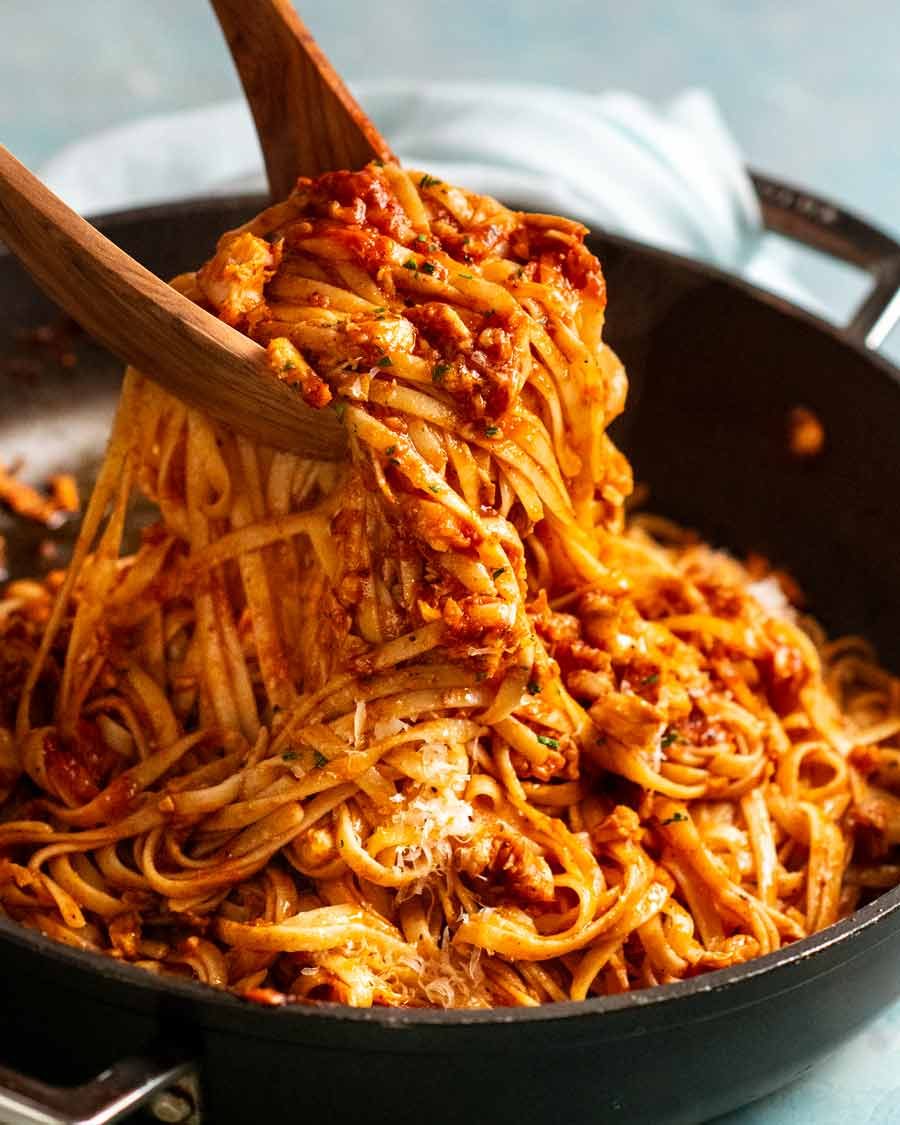
Now, it’s ready for serving. Twirl into bowls and cover liberally with a shower of the crunchy pangrattato and finish with parmesan!
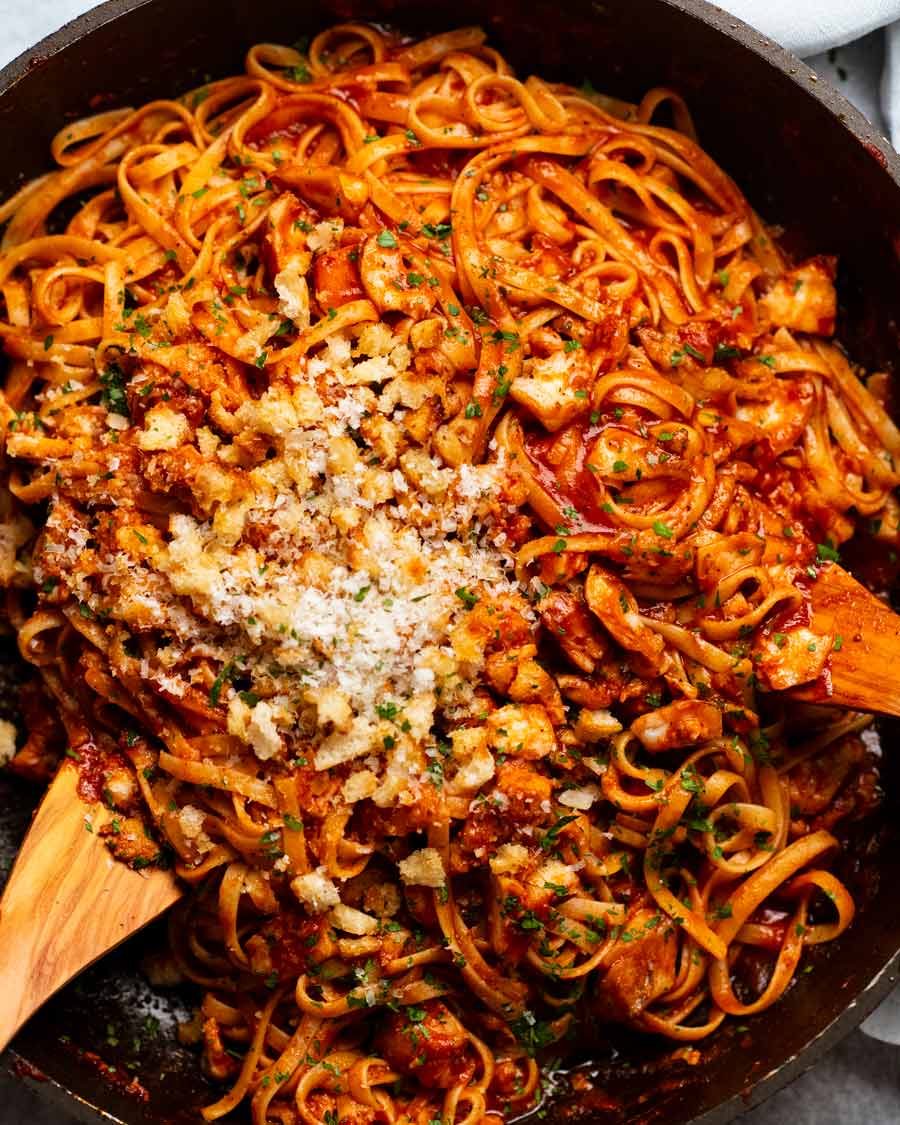
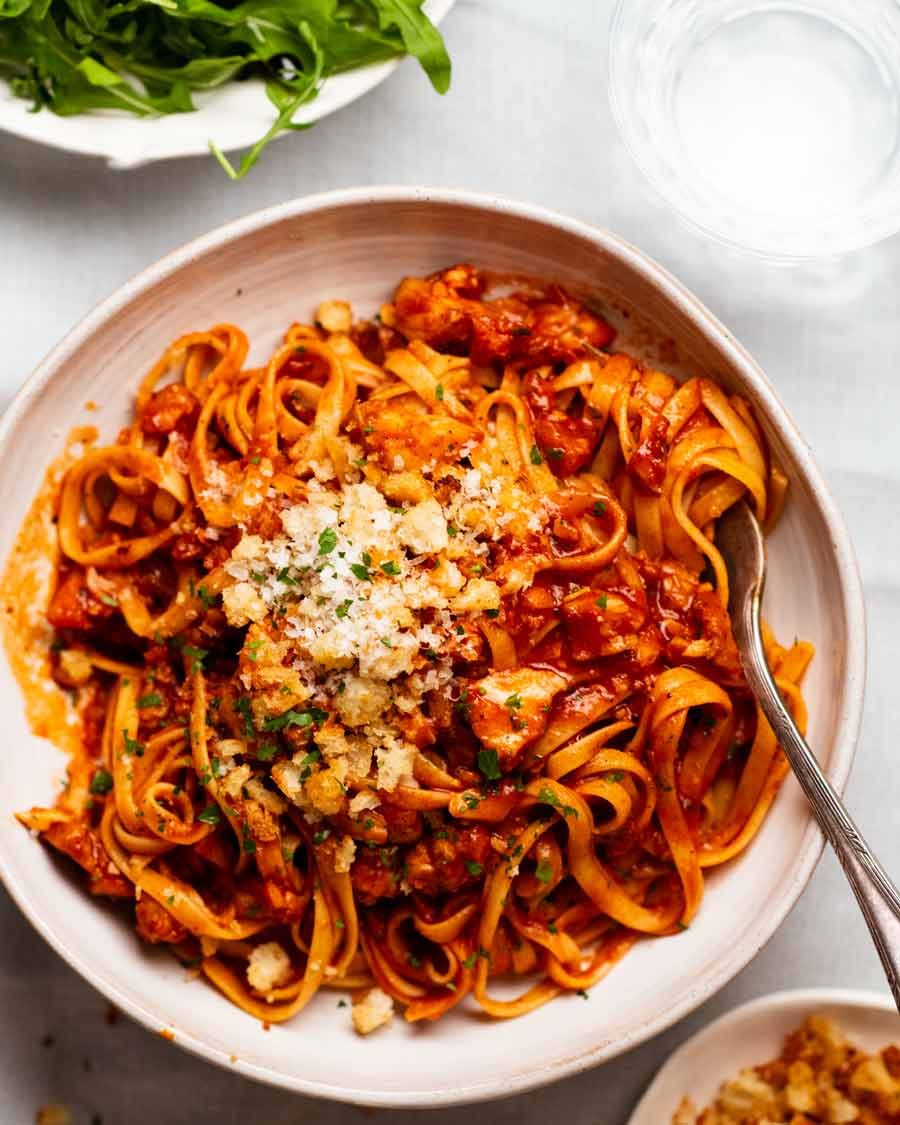
Matters of serving fish ragu
As with any pasta, this fish ragu is best served and eaten piping hot and fresh, straight out of the pan while the pasta is sticky and slippery and saucy. As it sits around, the pasta continues to absorb the liquid, drying it out so it’s thick and stodgy.
So, whenever you are making any pasta, be sure to have the hungry hoards at the table, ready to twirl and slurp the moment you bring the pasta bowls to the table, for maximum enjoyment!
Really hope you love this as much as I do. The fish ragu is divine as it is. But with that crunchy pangrattato? It’s sheer perfection. Enjoy! – Nagi x
Watch how to make it
Hungry for more? Subscribe to my newsletter and follow along on Facebook, Pinterest and Instagram for all of the latest updates.
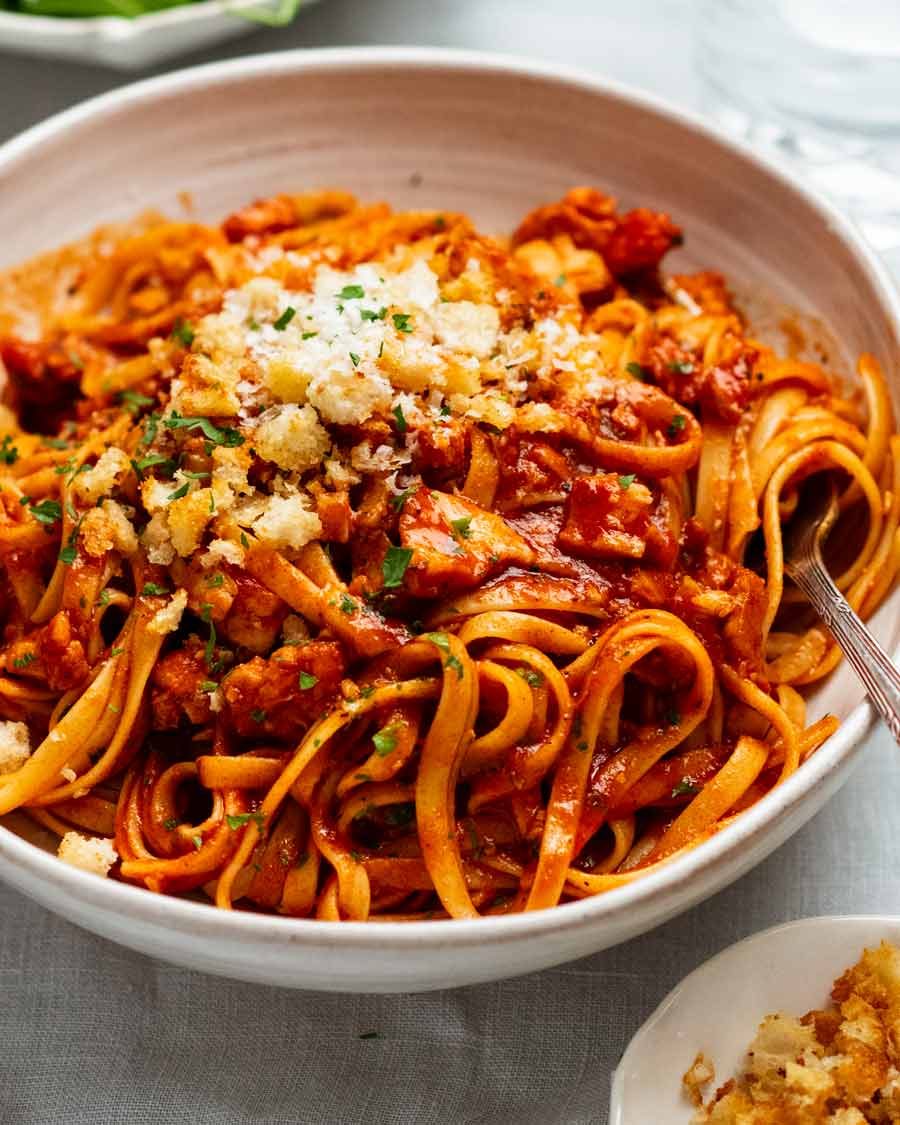
Calabrian Fish Ragu
#wprm-recipe-rating-0 .wprm-rating-star.wprm-rating-star-full svg * { fill: #343434; }#wprm-recipe-rating-0 .wprm-rating-star.wprm-rating-star-33 svg * { fill: url(#wprm-recipe-rating-0-33); }#wprm-recipe-rating-0 .wprm-rating-star.wprm-rating-star-50 svg * { fill: url(#wprm-recipe-rating-0-50); }#wprm-recipe-rating-0 .wprm-rating-star.wprm-rating-star-66 svg * { fill: url(#wprm-recipe-rating-0-66); }linearGradient#wprm-recipe-rating-0-33 stop { stop-color: #343434; }linearGradient#wprm-recipe-rating-0-50 stop { stop-color: #343434; }linearGradient#wprm-recipe-rating-0-66 stop { stop-color: #343434; }
Ingredients
Calabrian spiced fish:
- 250g/ 8 ozfirm white fish fillets, skinless, boneless, cut into 2 cm / 0.8″ cubes (barramundi, snapper, cod – Note 1)
- 3/4tspblack peppercorns(Note 2 for ground option)
- 1tspfennel seeds(Note 2 for ground option)
- 1tbspsmoked paprika(sub ordinary paprika)
- 1/2tspred chilli flakes(red pepper flakes), feel free to reduce/omit
- 1/2tspnutmeg powder
- 1/2tspcaster / superfine sugar
- 3/4tspcooking / kosher salt
- 3tbspextra virgin olive oil
- 2tbsptomato paste
Pasta:
- 250g/8 ozlinguine pasta(or fettuccine, spaghetti)
- 1tbspcooking / kosher salt, for pasta water
- 1 1/2tbspextra virgin olive oil
- 3garlic cloves, finely minced
- 3/4cuptomato passata(US: tomato puree, Note 3)
Garnish:
- 1tbspfinely chopped parsley
- Parmesan cheese, finely grated, for serving
Pangrattato
- 1cupstale bread like sourdough, ciabatta, crusts removed, torn/chopped into irregular 1cm/0.4″ pieces (Note 4)
- 2tspextra virgin olive oil
- 1pinchcooking / kosher salt
Instructions
-
Toast & grind – Preheat a large deep skillet or pot over medium heat (Note 5), no oil. Toast black peppercorn and fennel for 1 1/2 to 2 minutes until it smells fragrant and the fennel is lightly browned. Transfer to a mortar and use a pestle and grind to a powder while still hot.
-
Coat fish – Transfer to a medium bowl with remaining Calabrian spiced fish ingredients. Stir well with a spatula until combined. Set aside.
-
Cook pasta – Boil 3 litres of water with the cooking salt. Cook pasta per packet directions minus 1 minute. Just before draining, scoop out 1 1/2 cups pasta cooking water. Then drain in a colander and leave until ready to use.
-
Calabrian fish ragu – While the pasta is cooking, heat olive oil in the same skillet you used to toast the fennel on medium high. Add garlic and cook for 1 minute. Add the fish. Cook for 2 minutes, stirring regularly. Add tomato passata. Simmer for 5 minutes, stirring occasionally. Add 1 cup of the reserved pasta cooking water and simmer for 2 minutes.
-
Toss pasta – Add pasta and 3/4 of the parsley. Toss for 1 minute to coat the pasta with the sauce. Most of the fish will break up into flakes but some will remain in larger chunks – this is good! We don’t want disintegrated mush, nor giant chunks. Once the pasta turns red and the sauce and fish bits are clinging to the pasta straws, remove from heat and divide between bowls immediately.
-
Serve – Sprinkle with pasta, pangrattato and parmesan. Eat immediately!
Pangrattato:
-
Preheat oven to 180°C / 350°F (160°C fan-forced).
-
Toss bread, oil and salt in a small bowl. Spread on a tray and bake for 10 minutes, tossing at the 5 minute mark, or until light golden and fully crisp.
Recipe Notes:
- Fish that dry out easily when cooked – Like swordfish, tuna, bonito, kingfish, marlin.
- Delicate and thin-filleted fish – Like flounder, sole, plaice, turbot, whiting. The texture of the flesh is a bit too delicate for this type of cooking.
- Oily fish – Like sardines or mackerel. A bit too overwhelming, flavours don’t quite match.
2. Grinding whole spices will give the best flavour in this recipe, it really makes a difference here. I only emphasise this when it matters, I will use pre-ground whenever I can! But you can use pre-ground if that’s all you’ve got. 1/2 tsp coarsely ground black pepper and 1/2 tsp fennel powder. No toasting, just mix in with other spices.3. Tomato passata – Pureed, strained pure tomatoes, sometimes labelled “tomato puree” in the US (here’s a photo of Mutti tomato passata sold at Walmart). Readily available in Australian supermarkets nowadays, alongside pasta sauces. Excellent for making thick, smooth sauces. More on tomato passata here.4. Back up – use 1/2 cup panko instead, toast for shorter time. If the bread isn’t stale that’s fine too, it’ll take a little longer to go crunchy and is a little harder to cut into small pieces.5. Cooking vessel needs to be large enough to toss the sauce with the pasta.6. Recipe reference – inspired by this recipe torn out from the Delicious magazine during a flight. Though, my resulting recipe is very different. Much saucier (good thing), faster (also a good thing) with bolder flavours (that’s just how I roll!).7. Leftovers will keep for 3 days in the fridge. Warm in microwave with a splash of water and toss well. Store pangrattato in the pantry.Nutrition per serving assuming 3 servings.
Nutrition Information:
More things to make with fish!
Life of Dozer
My house needed a major air-out over the weekend after a particularly intense week of spice-heavy cooking, so I left all the doors open all day to create a nice breezeway.
Dozer was put on front door guard duty. I felt totally safe.

